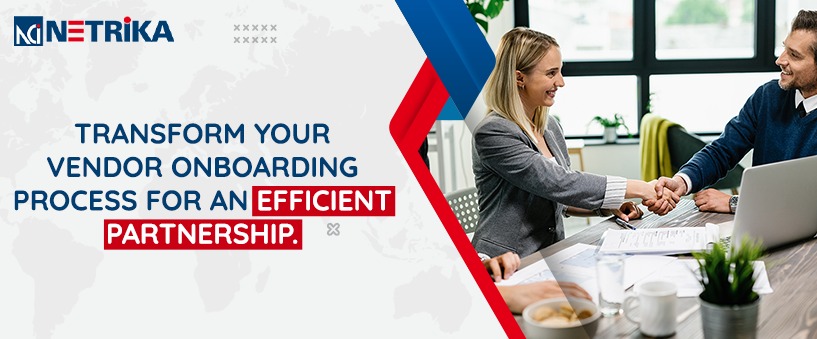- May 28, 2024
- Posted by: Netrika
- Category: Due Diligence

A seamless vendor onboarding process ensures an efficient partnership and business relationship. It also confirms that the two parties share common goals, deliverables, and resources and form shared strategies for managing evolving threats in the business landscape.
Another critical aspect of vendor onboarding is vendor risk assessments and monitoring, which help organisations identify, evaluate, and manage vendor-related risks while maintaining compliance with security practices to ensure a strong security posture. Hence, an extensively conducted vendor onboarding exercise would address each element in the vendor risk assessment checklist, heightened transparency, accountability, trust amongst partners, and protection of financial and reputational interests over a long-term period for the success and growth of the business.
What is Vendor Onboarding Process?
Vendor Onboarding is an organisation’s process for effectively bringing new vendors into its ecosystem. The vendor management process includes several different activities, such as Selecting vendors. The vendor selection process includes researching and sourcing suitable vendors, seeking quotes via requests for quotation (RFQs) and requests for proposals (RFPs), and shortlisting and selecting vendors.
Some of the important components of the vendor onboarding process are:
➢ Vendor Selection: Identify potential suppliers against defined elements such as competency, reputation, pricing, and compliance criteria.
➢ Vendor Evaluation and Due Diligence: Conduct extensive examinations to assess supplier capacity, financial viability, security practices, and adherence to regulatory standards.
➢ Contract Negotiation: Discussion on terms and conditions of agreement, price issues involved in service-level agreements (SLAs), and other contractual terms that should align with organisational needs and objectives.
➢ Documentation and Paperwork: Gathering and reviewing necessary documents like contract copies, insurance certificates, W-9 Forms, and other required legal or compliance documents.
➢ Integration and Training: Incorporation into the organisation’s systems, processes, or workflows while being provided with any necessary assistance or training to ease the smooth changeover.
➢ Ongoing Monitoring and Management: Regularly checking the supplier’s performance indicators, including risk factors throughout the partnership period; also, whenever required, this can address concerns or problems that might exist thereon.
When they follow a structured vendor onboarding process, organisations can minimise risks and streamline operations, thereby creating fruitful alliances.
What is the Process of Vendor Onboarding?
Supplier (or vendor) onboarding is the process of collecting necessary information from suppliers used for procurement to set them up as approved sellers with your company. This process aims to help you do business together, buy goods and services, and pay vendors.
Vendor onboarding, also known as supplier onboarding or vendor intake, is the process of gathering and providing information to establish a relationship with a new vendor. During onboarding, new vendors answer standard questions and provide documentation as needed.
Key steps in the vendor onboarding process
1) Vendor risk assessments and due diligence: This process incorporates vetting the crucial aspects of operational capacity, finances, informational security data protection, regulatory compliance, technical infrastructure, concentration, etc. Before onboarding a vendor, an organisation must tick this process off their vendor risk assessment checklist by analysing the vendor’s overall risk profile. This is followed by examining the agreement to monitor and control the risk landscape and conducting appropriate due diligence to assess the vendor’s financial stability, security practices, and regulatory compliance. Further, a consideration step is performed to ensure a smooth vendor onboarding transition with robust internal control and operational resilience.
2) Selection and procurement: After conducting risk assessment, the organisation follows the vendor selection and procurement process. This includes evaluating vendor proposals, negotiating terms and conditions, finalising contracts and service level agreements (SLAs), standardising pricing, etc., with the selected vendor.
3) Implementing a registration and data collection platform: A streamlined vendor onboarding process that incorporates thorough vendor risk assessments must include a platform for registration and data collection. This enables the organisation to collect vendor documents such as insurance certificates, contracts, compliance forms, etc. This single platform for electronically submitting documents centralises information sharing and ensures seamless and secure document storage.
4) Establish a communication system: Effective communication between the organisation and vendor is key to successful business operations. This encompasses sharing regular updates and milestone reports and maintaining transparency and accountability in situations that involve deviations or risks.
5) Vendor onboarding: Finally, when onboarding vendors after undergoing a thorough vendor risk assessment, organisations must have relevant systems and platforms that enable seamless integration of vendors into the existing operations. It will also include regular vendor training sessions to ensure zero operational and risk gaps.
The significance of the vendor onboarding process starts with effective assessment, continuous monitoring, and following a set of risk management practices. Businesses need to assess risks first before making any moves to minimise the related exposures. In this case, businesses need to invest considerable resources to optimise the onboarding processes, which will help them build successful long-term relationships that drive value and innovation. This will help them minimise the risk exposure during onboarding and build trust-based partnerships that drive long-term success.
Every organisation needs to allocate enough internal personnel and funds for vendor risk management (VRM) services to support an onboarding partnership culture of robust security posture. By contracting with a certified security partner for a fraction of the cumulative risk management effort, an organisation can enhance its vendor risk management skills while saving some critical in-house resources.
With its in-depth knowledge of physical and digital security trends and its team of qualified professionals who can conduct vendor risk assessments, Netrika can help your company become more resilient and proactive to these threats. As a vendor risk management services provider, we offer an impartial and objective evaluation of your supply chain, providing peace of mind that the vendors you interact with are dependable and value information security just as much as you do.
